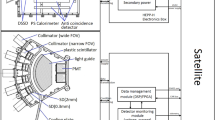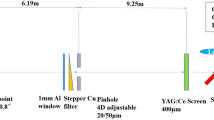Abstract
The pitch-angle distribution of energetic particles is important for space physics studies on magnetic storm and particle acceleration. A ‘pin-hole’ imaging structure is built with the ‘pin-hole’ technique and a position sensitive detector, which can be used to measure the pitch angle distribution of energetic particles. To calibrate the angular response of the ‘pin-hole’ imaging structure, special experiment facilities are needed, such as the particle accelerator with special design. The features of this kind of particle accelerator are: 1) The energy range of the outgoing particles should be mid-energy particles (tens keV to several hundred keV); 2) the particle flux should be consistent in time-scale; 3) the directions of the outgoing particles should be the same and 4) the particle number within the spot should be low enough. In this paper, a method to calibrate the angular response of the ‘pin-hole’ imaging structure by the 90Sr/90Y β source with a collimator is introduced and simulated by Geant4 software. The result of the calibration with the collimated β source is in accord with the Geant4 simulations, which verifies the validity of this method.
Similar content being viewed by others
References
Baker D N, Pulkkinen T I, Li X, et al. Coronal mass ejections, magnetic clouds, and relativistic magnetospheric electron events: ISTP. J Geophys Res, 1998, 103: 17279–17291
Reeves G D. Relativistic electrons and magnetic storms: 1992–1995. Geophys Res Lett, 1998, 25: 1817–1820
Baker D N, Elkington S R, Li X, et al. Particle Acceleration in The Inner Magnetosphere: Physics and Modelling. Washington D C: AGU, 2005. 73–85
Roberts C S. Pitch-angle diffusion of electrons in the magnetosphere. Rev Geophys, 1969, 7: 305–337
West Jr H, Buck R, Walton J. Electron pitch angle distributions throughout the magnetosphere as observed on Ogo 5. J Geophys Res, 1973, 78: 1064–1081
Morioka A, Misawa H, Miyoshi Y. Pitch angle distribution of relativistic electrons in the inner radiation belt and its relation to equatorial plasma wave turbulence phenomena. Geophys Res Lett, 2001, 28: 931–934
Horne R B, Meredith N P, Thorne R M, et al. Evolution of energetic electron pitch angle distributions during storm time electron acceleration to megaelectronvolt energies. J Geophys Res, 2003, 108: 1016
Summers D, Thorne R M. Relativistic electron pitch-angle scattering by electromagnetic ion cyclotron waves during geomagnetic storms. J Geophys Res, 2003, 108: 1143
Gannon J L, Li X, Heynderickx D. Pitch angle distribution analysis of radiation belt electrons based on CRRES MEA data. J Geophys Res, 2007, 112: 5212
Baker D N. How to cope with space weather. Science, 2002, 297: 1486–1487
Lin R P. A three-dimensional plasma and energetic particle investigation for the wind spacecraft. Space Sci Rev, 1995, 71: 125
Korth A, Kremser G, Wilken B, et al. Electron and proton wide-angle spectrometer (EPAS) on the CRRES spacecraft. J Spacecraft Rockets, 1992, 29: 609–614
Black J B. CEPPAD experiment on POLAR. Space Sci Rev, 1995, 71: 531
Wilken B. RAPID: The imaging energetic particle spectrometer on cluster. Space Sci Rev, 1997, 79: 399–473
Coakley P, Kitterer B, Treadaway M. Charging and discharging characteristics of dielectric materials exposed to low-and mid-energy electrons. IEEE Trans Nucl Sci, 1982, NS-29: 1639–1643
Han J W, Zhang Z L, Huang J G, et al. An environmental simulation facility for study of deep dielectric charging on satellites. Spacecraft Environ Eng, 2007, 24: 47–50
Ryden K A, Morris P A, Rodgers D J, et al. Improved demonstration of internal charging hazard using erealistic electron environment facility (REEF). In: the Proc. 8th Spacecraft Charging Technol. Conf., Huntsville, 2003
Coakley P G, Treadaway M J, Robinson P A. Low flux laboratory test of the internal discharge monitor (IDM). IEEE Tran Nuc Sci, 1985, 32: 4066–4072
Agostinelli S, Allison J, Amako K, et al. Geant4-a simulation toolkit. Nuclear Instrum Meth Phys Res-Sec A, 2003, 506: 250–303
Gao B R, Hao Y Q, Jiao W X. A study on spacecraft internal charging with MONTE CARLO method. Chin J Space Sci, 2004, 24: 289–294
Allison J, Amako K. Geant 4 developments and applications. IEEE Trans Nucl Sci, 2006, 53: 270–278
Hao Y Q, Jiao W X, Chen H F. A Monte carlo study on internal charging of onboard subsystem during the July 2004 energetic electron event (in Chinese). Prog Geophys, 2009, 24: 1937–1942
Li X C, Chen H F, Hao Y Q, et al. Investigation of electrons inside the satellite by the Geant4 simulation. Sci China Tech Sci, 2011, 54: 2271–2275
Author information
Authors and Affiliations
Corresponding author
Rights and permissions
About this article
Cite this article
Zou, H., Luo, L., Li, C. et al. Angular response of ‘pin-hole’ imaging structure measured by collimated β source. Sci. China Technol. Sci. 56, 2675–2680 (2013). https://doi.org/10.1007/s11431-013-5376-1
Received:
Accepted:
Published:
Issue Date:
DOI: https://doi.org/10.1007/s11431-013-5376-1




